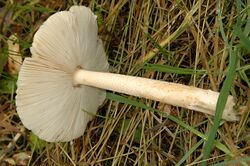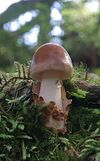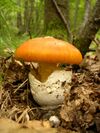Biology:Amanita crocea
| Saffron ringless amanita | |
|---|---|

| |
| Amanita crocea from Commanster, Belgium | |
| Scientific classification | |
| Domain: | Eukaryota |
| Kingdom: | Fungi |
| Division: | Basidiomycota |
| Class: | Agaricomycetes |
| Order: | Agaricales |
| Family: | Amanitaceae |
| Genus: | Amanita |
| Species: | A. crocea
|
| Binomial name | |
| Amanita crocea (Quél. in Bourd.) Singer ex Singer
| |
| Synonyms[1] | |
| |
| Amanita crocea | |
|---|---|
| Mycological characteristics | |
| gills on hymenium | |
| cap is flat or convex | |
| hymenium is free | |
| stipe has a volva | |
| spore print is white | |
| ecology is mycorrhizal | |
| edibility: edible but not recommended | |
Amanita crocea, the saffron ringless amanita,[2] is a species of Amanita widely distributed in Europe. It is not recommended for consumption due to its similarity to poisonous species of the genus.
Description
- Cap: The cap is free of rings with the volva and has a diameter of 5–10 centimetres (2–4 inches), yellow-orange in colour with an apricot tinge at the centre. It expands to become flat or sometimes convex at the umbo, a small raised central area.
- Volva: Thick, white, at least 4–10 cm (1 1⁄2–4 in) wide, saffron orange or a little browner than that in colour in the centre when fresh and paler at the margin.
- Gills: Gills are free and cream in mass (sometimes with a slight salmon or pinkish reflection, and 2–3± millimetres broad.)
- Stem/stipe: The stem or stipe is 10–15 cm (4–6 in) long and 1–1.5 cm in diameter, tapering, decorated with paler fibrils in a "flame" pattern, with the decoration later becoming orange or brown-orange (darker than the underlying stipe surface) with a membranous sack-like volva at the base.
- Spores: The white spores measure (8.0-) 9.4 - 11.8 (-18.8) x (7.5-) 8.5 - 11.0 (-16.0) µm.[3][4]
Similar species
It is similar to Amanita fulva (orange-brown ringless amanita or tawny grisette) and A. caesarea (Caesar's mushroom), belonging to the Vaginatae and Caesareae sections of the Amanita genus, respectively.
The edible tawny grisette is a basidiomycete mushroom located in North America and Europe.[5] It is easily confused with the 'death cap', though is not as substantial. The structure is relatively flimsy and the hollow stem often breaks, even when handled very gently.[6] It has fibres on its stalk usually.[7]
The second similar species, the Caesar's mushroom, is the type species (a species to which the name of a genus is permanently linked) of the Caesareae section of the genus Amanita. It has a distinctive orange cap, yellow gills and stem. Similar orange-capped species occur in North America and India.[8][9]
Ecology
The fungi can occur infrequently between July and October in mycorrhizal with hardwood trees, particularly birch and beech in clearings. Its odour is sweet-smelling and it has a mildly nutty sweet taste.[10] It has also been reported from Iran.[11]
Uses
While edible, guides advise not to eat it as many similar-looking Amanitas are very poisonous.[12]
See also
References
- ↑ "Amanita crocea (Quél.) Singer 1951". MycoBank. http://www.mycobank.org/MycoTaxo.aspx?Link=T&Rec=115109.
- ↑ "Standardized Common Names for Wild Species in Canada". 2020. https://www.wildspecies.ca.
- ↑ "Amanita crocea". http://www.njcc.com/~ret/amanita/species/croceas.html.
- ↑ http://www.first-nature.com/fungi/id_guide/amanitaceae/amanita_crocea.php Amanita crocea-Pictures, habitat and identification guide.
- ↑ http://www.rogersmushrooms.com/gallery/DisplayBlock~bid~5539.asp Rogers mushrooms.
- ↑ http://www.wildaboutbritain.co.uk/tawny-grisette Tawny Grisette | Wild About Britain.
- ↑ http://www.mushroomthejournal.com/greatlakesdata/Taxa/Amanifulva22.html Amanita fulva
- ↑ Amanita caesarea. http://alphagamma.150m.com/Amanita_caesarea.html
- ↑ http://www.eticomm.net/~ret/amanita/species/caesarea.html by R.E. Tulloss.
- ↑ "Amanita crocea". http://www.first-nature.com/fungi/id_guide/amanitaceae/amanita_crocea.php.
- ↑ Bahram, M; Asef, M. R.; Zarre, Sh.; M. Abbasi; S. Reidl (2006). "Addition to the knowledge of Amanita (Agaricales, Pluteaceae) from Iran". Rostaniha 7 (2): 107–119. ISSN 1608-4306.
- ↑ Phillips, Roger (2010). Mushrooms and Other Fungi of North America. Buffalo, NY: Firefly Books. p. 22. ISBN 978-1-55407-651-2.
Wikidata ☰ Q1574920 entry
 |





